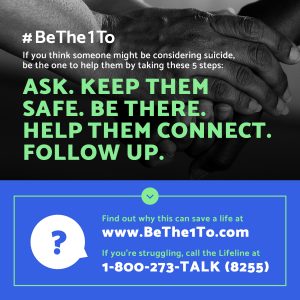Suicide Prevention Awareness – What Can I Do?
By: Administrator
Date: September 28th, 2018
 September is suicide prevention awareness month, a time to highlight the steps individuals can take to support loved ones who might be thinking about suicide. Evidence suggest that straightforward, concrete actions in response to a person having suicidal thoughts, including asking about suicide directly, reducing access to lethal means, being there, connecting to support, and following up, can help save lives.
September is suicide prevention awareness month, a time to highlight the steps individuals can take to support loved ones who might be thinking about suicide. Evidence suggest that straightforward, concrete actions in response to a person having suicidal thoughts, including asking about suicide directly, reducing access to lethal means, being there, connecting to support, and following up, can help save lives.
The National Suicide Prevention Lifeline (1-800-273-8255) says that the following behaviors may indicate an individual is thinking about harming themselves, especially if these behaviors have changed or increased recently.
- Talking about wanting to die or to kill themselves
- Looking for a way to kill themselves, like searching online or buying a gun
- Talking about feeling hopeless or having no reason to live
- Talking about feeling trapped or in unbearable pain
- Talking about being a burden to others
- Increasing the use of alcohol or drugs
- Acting anxious or agitated; behaving recklessly
- Sleeping too little or too much
- Withdrawing or isolating themselves
- Showing rage or talking about seeking revenge
- Extreme mood swings
Certain populations are also statistically more vulnerable to suicide, including American Indian and Alaska natives, veterans, LGBTQ individuals, and older men. If you are thinking about suicide, call the National Suicide Prevention Lifeline at 1-800-273-8255.
The National Suicide Prevention Lifeline highlights the following steps to #BeThe1To help someone thinking about suicide:
- Ask directly. Research has shown direct questions help open the door for people to talk about how they’re feeling and ask for help. Asking a person whether they are thinking about suicide or hurting themselves has not been found to have adverse effects. After you’ve asked the question, listen calmly, without judgment, to encourage them to share openly with you.
- Keep them safe. If a person is thinking about suicide, an important early step is to limit their access to objects they could use to hurt themselves, especially if they’ve been thinking about a specific suicide method. This can include firearms, medication, poison, knives, or other dangerous objects. These items can be locked securely or removed entirely from the home.
- Be there. Do what you can to show the person you support them, which may mean being with them physically, talking on the phone, or arranging for someone else to join them. Limiting isolation for someone in crisis is important.
- Help them Connect. You’ve taken the vital first steps, but now it’s time to let professionals help as well. The Suicide Prevention Lifeline is a quick resource available 24/7, via talk or text, and also includes Spanish language support and TTY options for the deaf and hard of hearing. It is also good to discuss the mental health resources available to the individual in their community and develop a safety plan.
- Follow up. Knowing someone cares about them goes a long way toward helping someone in crisis. In the days, weeks, and months following the crisis, continue to touch base and ask how they’re doing.
These steps have been proven to be effective at reducing and preventing suicide. Most people who consider suicide or survive a suicide attempt do not end up dying by suicide, and the actions of the people around them can make a difference. Learning to identify warning signs and then ask directly, keep them safe, be there, help them connect, and follow up can save lives.
Additional Resources:
Pacific Northwest Suicide Prevention Resource Center
Safer Homes Suicide Aware
Forefront
National Suicide Prevention Lifeline
American Association of Suicidology

 September is suicide prevention awareness month, a time to highlight the steps individuals can take to support loved ones who might be thinking about suicide. Evidence suggest that straightforward, concrete actions in response to a person having suicidal thoughts, including asking about suicide directly, reducing access to lethal means, being there, connecting to support, and following up, can help save lives.
September is suicide prevention awareness month, a time to highlight the steps individuals can take to support loved ones who might be thinking about suicide. Evidence suggest that straightforward, concrete actions in response to a person having suicidal thoughts, including asking about suicide directly, reducing access to lethal means, being there, connecting to support, and following up, can help save lives.